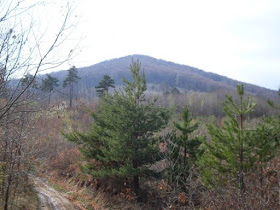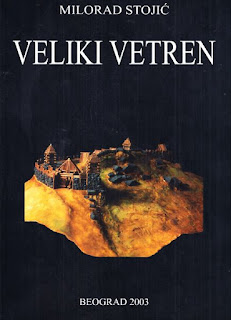This is an amazing photo by Rob Shaw of the Poulnabrone (Irish: Poll na Brón) dolmen. Around 33 human remains were found buried underneath it which were dated to between 5800 BP (or is it calibrated BP?) and 5200 BP (or is it calibrated BP?)...
The dolmen is located in Burren, a barren limestone area in the north of the county Claire, West of Ireland...
Pollen analysis indicates that in the Mesolithic period the Burren looked completely different from today, with most of the uplands covered in a mixture of deciduous, pine and yew trees. No clear evidence of Mesolithic settlements or camp sites in the area has yet been discovered.
However, by the Neolithic, c. 5100BP (5800 calibrated BP), settlers had clearly arrived and began changing the landscape through deforestation, likely by overgrazing and burning, and the building of stone walls.
These people also constructed Megalithic sites like the Poulnabrone dolmen. In total 70 megalithic tombs were built in the Burren area...
Now the remains found in the Poulnabrone dolmen showed signs of arthritis, illness and malnutrition. In most cases the physical condition of the remains indicated lives spent in hard physical labour. Everyone died by the age of 30...So agriculture was not very successful, I would say...
In it we can read about "the Elm Decline", the decimation of the Irish elms which is thought to be a result of a disease which affected only elms. The event is dated to around 5100BP (5800 calibrated BP).
Interestingly the earliest evidence of the Neolithic landnam (the clearance of forested land for (usually short-term) agricultural purposes) is from the period immediately after the Elm Decline. The effects of this land clearance can be seen in substantial reductions in arboreal pollen (frequently in all taxa) and correspondingly large increases in the non-arboreal pollen component. Basically trees were replace by grasses.
Examples from Ce´ide Fields and Lough Sheeauns and the pollen record from Garrynagran, which lies immediately to the south of Ce´ide Fields show that landnam involved clearance and sustained farming activity over several centuries (c. 300 –500 years).
The farming was mainly animal herding. Grain was grown, but as a minor element in the farming economy.
However, farming completely stops around 4500BP (5200 calibrated BP)...After this point we see evidence of woodland regeneration facilitated by low levels of farming and possibly more or less complete abandonment of farming in several parts of Ireland. By the end of this period 4000BP (4500 calibrated BP), blanket bog had already expanded or was about to undergo widespread expansion. At Ce´ide Fields, it already extended over the greater part of the fields that had been enclosed in the earlier Neolithic by stone walls.
So here is the question: Why did agriculture in Neolithic Burren last such a short period of time and why was it so unsuccessful that people literally starved and died young from diseases and malnutrition?
I don't know if what I will present here will answer this question or open even more questions, but here it goes:
This is the chart of the polar temperature variation in last 10,000 years
We can see that the temperature has been going up and down madly all the time and that for most of the time it was much higher than today. But I am not going to talk about climate change here. I want to talk about specific dramatic temperature rises and drops which occurred during the time of the Early Neolithic settlements in the Burren area. What I want to see is if the sudden changes in climate were responsible for the relatively short span and unsuccessfulness of the Neolithic agriculture in the Burren area.
Now in order to do this analysis we need to decide which archaeological dates should we match with the above temperature chart dates. The archaeological dates are given in BP (before present) and calibrated BP...
Apparently, the BP dates retrieved using C14 carbon dating "are not identical to calendar dates". This "has to do with the fact that the level of atmospheric radiocarbon (carbon-14 or 14C) has not been strictly constant during the span of time that can be radiocarbon-dated". Uncalibrated radiocarbon ages can be converted to calendar dates by means of calibration curves "based on comparison of raw radiocarbon dates of samples independently dated by other methods, such as dendrochronology (dating on the basis of tree growth-rings) and stratigraphy (dating on the basis of sediment layers in mud or sedimentary rock)".
The quotes are not here because I don't agree with calibration. There are here because calibration is not an exact science...And calibrated dates are not "the correct dates". They are just "better dates". I talked about the problems with C14 dates calibration in my article "Linkardstown cists".
The problem with calibration is that calibration wildly changes the dates obtained by C14 carbon dating. As you can see from the above dates for the arrival of the first farmers to the Burren, calibration makes the dates 700 years earlier...700 years is a lot of time, especially when you want to correlate dates from one part of the world with dates from another, to determine the direction of population movement and cultural influence...But that's the best we have at the moment...
Let's plot the calibrated dates from the Burren onto the Polar temperature chart to see if we can spot anything interesting.
And here is the important bit enlarged
You can see that our poor Neolithic Farmers arrived to the Burren right during the sudden cooling (green line) caused most likely by an eruption of the Hekla volcano on Iceland which happened around 5900BP. Volcano eruptions of Hekla type spew huge amount of ash into the atmosphere and cause basically nuclear winters...Not very good for agriculture...
They somehow get through this "bad patch" and are doing "ok" for a while (temperatures rising to the halfway point between the green and the purple line). When something else causes a temperature drop that makes the one caused by Hekla eruption look like a "minor bad weather spell".
This time we can't blame Hekla for what's going on...We can blame the so Called "Piora Oscillation". The climate got progressively colder and damper and eventually made agriculture impossible. Which is why by the time this period is over, we see no traces of agriculture in the Burren any more.
As the temperature starts to rise (after the purple line), the forests start to recover.
But then around 5100BP we have another catastrophic climate change with huge temperature dip. We are talking about ice age conditions...
So what is this big dip? And, is it possible that this dip could be an indication that the calibration of the Irish C14 carbon dates is wrong? Have a look at what we get when we plot the actual C14 dates and not the calibrated ones on the above Ice Core Temperature chart.
Now our Neolithic Farmers arrive to Ireland right after the previous big dip which coincides with the Piora Oscillation, some time before 5200BP. They enjoy relative prosperity. They build Newgrange between 5200BP and 5100BP...
But then, just when they are getting comfortable, about 200 years after they arrived, they hit the beginning of the giant temperature dip. And then everything goest to hell...The temperature plummets. The climate becomes so cold and wet that it makes agriculture impossible. The bogs cover the fields...
Now I know that one of the main criticisms of these charts is that "you can't equate temperature variation data obtained on Greenland to temperature variation of the whole Earth". Fair enough, but Greenland is fairly close to Ireland, and we could be pretty sure that the Irish temperature variation was very similar to the one shown on the Greenland Ice Core Temperature charts...
Soooo...
Oh yeah. The Irish annals tell us that the first people that came to Ireland were Fomorians (The ones who came from across the sea). Then the flood came and Ireland was left depopulated. Then Partholon came. Then another flood came and Ireland was again left depopulated. Then Nemed came...
Now if we plot the calibrated dates on the Greenland Ice Core Temperature chart we get
And if we plot the calibrated dates on the Greenland Ice Core Temperature chart we get
Now the second one actually matches the date of the arrival of the R1b Metalworkers to Ireland sometime after 4500BP. And the Irish annals say that it was Partholon who brought metalwork...
I think this is quite interesting...
So as I said at the beginning of my discussion, not sure if what I just presented here gives us any answers, or opens a lot more questions...



















































